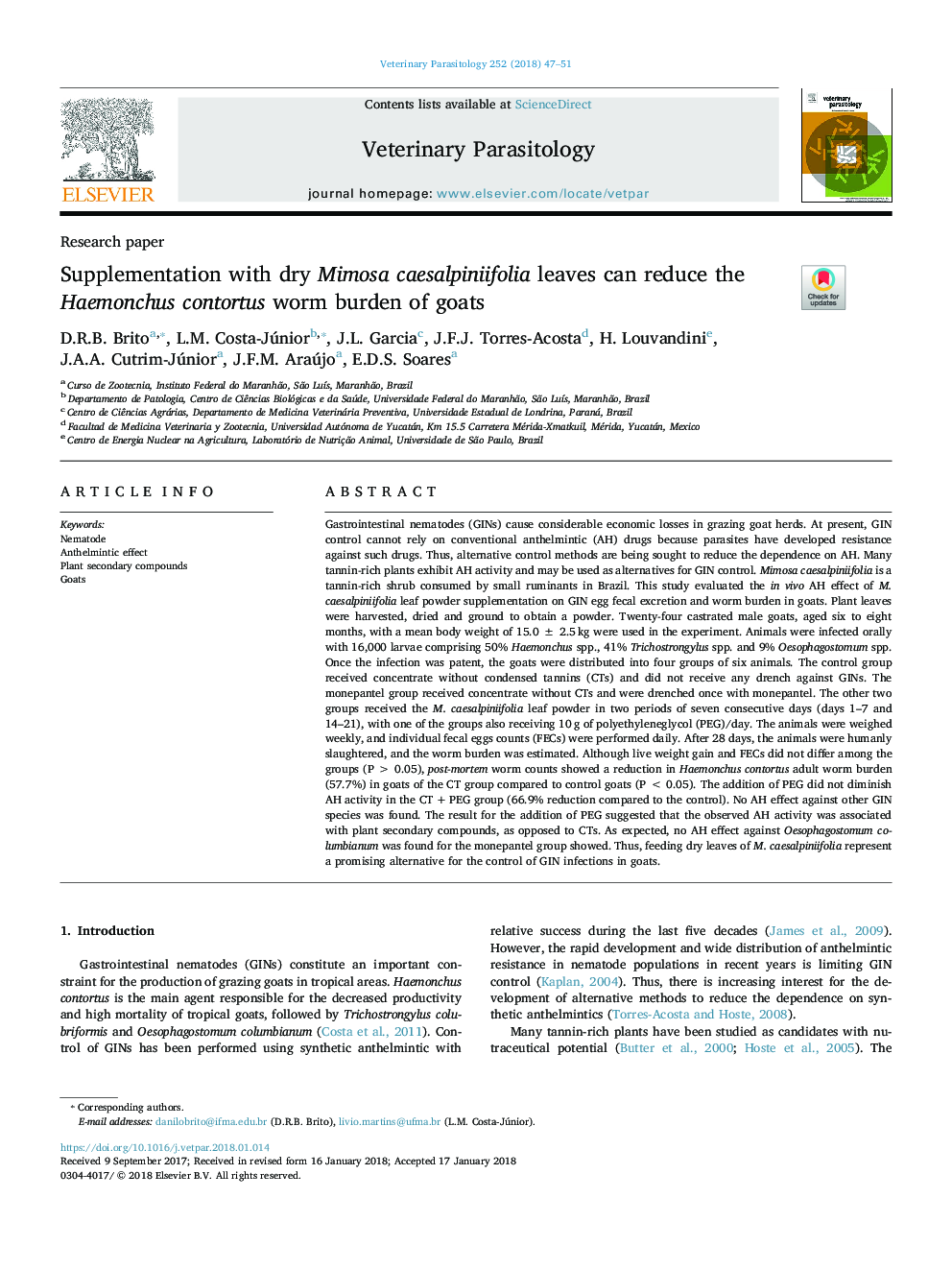| کد مقاله | کد نشریه | سال انتشار | مقاله انگلیسی | نسخه تمام متن |
|---|---|---|---|---|
| 8506100 | 1555624 | 2018 | 5 صفحه PDF | دانلود رایگان |
عنوان انگلیسی مقاله ISI
Supplementation with dry Mimosa caesalpiniifolia leaves can reduce the Haemonchus contortus worm burden of goats
دانلود مقاله + سفارش ترجمه
دانلود مقاله ISI انگلیسی
رایگان برای ایرانیان
کلمات کلیدی
موضوعات مرتبط
علوم زیستی و بیوفناوری
علوم کشاورزی و بیولوژیک
علوم دامی و جانورشناسی
پیش نمایش صفحه اول مقاله

چکیده انگلیسی
Gastrointestinal nematodes (GINs) cause considerable economic losses in grazing goat herds. At present, GIN control cannot rely on conventional anthelmintic (AH) drugs because parasites have developed resistance against such drugs. Thus, alternative control methods are being sought to reduce the dependence on AH. Many tannin-rich plants exhibit AH activity and may be used as alternatives for GIN control. Mimosa caesalpiniifolia is a tannin-rich shrub consumed by small ruminants in Brazil. This study evaluated the in vivo AH effect of M. caesalpiniifolia leaf powder supplementation on GIN egg fecal excretion and worm burden in goats. Plant leaves were harvested, dried and ground to obtain a powder. Twenty-four castrated male goats, aged six to eight months, with a mean body weight of 15.0â¯Â±â¯2.5â¯kg were used in the experiment. Animals were infected orally with 16,000 larvae comprising 50% Haemonchus spp., 41% Trichostrongylus spp. and 9% Oesophagostomum spp. Once the infection was patent, the goats were distributed into four groups of six animals. The control group received concentrate without condensed tannins (CTs) and did not receive any drench against GINs. The monepantel group received concentrate without CTs and were drenched once with monepantel. The other two groups received the M. caesalpiniifolia leaf powder in two periods of seven consecutive days (days 1-7 and 14-21), with one of the groups also receiving 10â¯g of polyethyleneglycol (PEG)/day. The animals were weighed weekly, and individual fecal eggs counts (FECs) were performed daily. After 28 days, the animals were humanly slaughtered, and the worm burden was estimated. Although live weight gain and FECs did not differ among the groups (Pâ¯>â¯0.05), post-mortem worm counts showed a reduction in Haemonchus contortus adult worm burden (57.7%) in goats of the CT group compared to control goats (Pâ¯<â¯0.05). The addition of PEG did not diminish AH activity in the CTâ¯+â¯PEG group (66.9% reduction compared to the control). No AH effect against other GIN species was found. The result for the addition of PEG suggested that the observed AH activity was associated with plant secondary compounds, as opposed to CTs. As expected, no AH effect against Oesophagostomum columbianum was found for the monepantel group showed. Thus, feeding dry leaves of M. caesalpiniifolia represent a promising alternative for the control of GIN infections in goats.
ناشر
Database: Elsevier - ScienceDirect (ساینس دایرکت)
Journal: Veterinary Parasitology - Volume 252, 15 March 2018, Pages 47-51
Journal: Veterinary Parasitology - Volume 252, 15 March 2018, Pages 47-51
نویسندگان
D.R.B. Brito, L.M. Costa-Júnior, J.L. Garcia, J.F.J. Torres-Acosta, H. Louvandini, J.A.A. Cutrim-Júnior, J.F.M. Araújo, E.D.S. Soares,